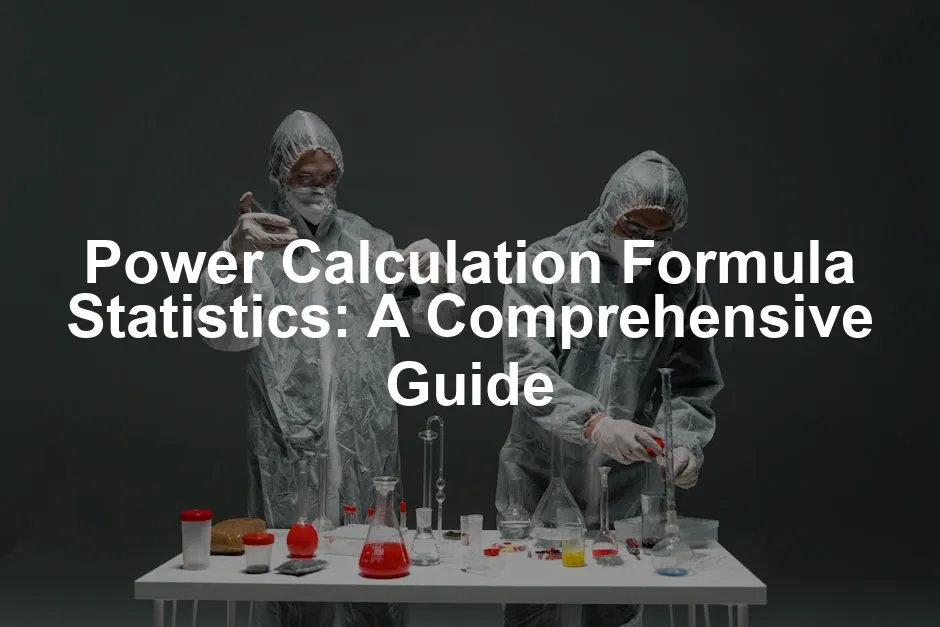Introduction
When we talk about statistical power, we’re diving into an essential aspect of hypothesis testing. So, what is statistical power? Simply put, it’s the probability that a test will correctly reject a false null hypothesis. Imagine trying to find a needle in a haystack. If you have a powerful magnet, you’re more likely to succeed. That’s what power does for your research!
Statistical power plays a pivotal role in research design. It ensures that your study is not just a shot in the dark, but a well-informed attempt to uncover meaningful results. Imagine conducting a clinical trial to test a new drug. If your study lacks power, you may miss detecting a real effect, leaving you with inconclusive findings. That’s like cooking a delicious meal but forgetting to serve it!
Now, why are power calculations vital? They help researchers determine the sample size needed to achieve reliable results. Proper power calculations prevent wasting resources on studies that are too small to detect an effect or unnecessarily large studies that could expose participants to risks. Think of it as planning a party: you wouldn’t want to invite too many guests or too few, right?
If you’re looking to get a solid grasp on statistical power analysis, consider picking up G*Power Software. It’s a powerful tool that helps you calculate the required sample size and understand the nuances of power analysis without breaking a sweat!
In this article, we’ll explore power calculation formulas and their applications in statistics. You’ll learn about the factors influencing power, how to conduct power analysis, and why understanding this concept is crucial for any researcher. By the end, you’ll be equipped with the knowledge to enhance your research design and make informed decisions that lead to valid results. So, let’s get started and turn those statistical uncertainties into powerful insights!

Understanding Statistical Power
What is Statistical Power?
Statistical power is a cornerstone of hypothesis testing. It’s the probability that a test will correctly reject a false null hypothesis (H₀). Mathematically, power is expressed as 1 – β, where β represents the probability of making a Type II error—failing to reject a false null hypothesis.
But why does this matter? The higher the power, the lower the chance of missing a real effect. For instance, if a study has 80% power, it means there’s an 80% chance of detecting an effect if it exists. Conversely, a low power increases the risk of Type II errors, which can lead to misleading conclusions.
The Relationship Between Power, Type I Error (α), and Type II Error (β)
Understanding the interplay between Type I and Type II errors is key to grasping statistical power. A Type I error (α) occurs when you reject a true null hypothesis, claiming a difference or effect exists when it does not. This is like proclaiming a new diet works when, in reality, it’s just a fad!
On the flip side, a Type II error (β) happens when you fail to reject a false null hypothesis, missing out on a true effect. This could mean overlooking a breakthrough treatment for a disease.
These errors are inversely related. When you decrease the probability of a Type I error by setting a stringent alpha level, you may inadvertently increase the likelihood of a Type II error. This is why finding the right balance is crucial! A common convention is to aim for a power of 0.80, minimizing Type II errors while keeping Type I errors manageable.
In summary, statistical power is crucial in ensuring that your research findings are valid and reliable. By understanding its relationship to Type I and Type II errors, you can design studies that accurately detect true effects, leading to more successful outcomes in your research journey.

Factors Influencing Statistical Power
Sample Size
Let’s kick things off with sample size. Think of it as the secret sauce in your statistical recipe. The larger your sample size, the more likely you are to detect an actual effect. Why? Because a bigger sample reduces the variability in your results. This means your estimates become more accurate. If you’ve ever tried to spot a trend in a tiny dataset, you know the struggle. It’s like trying to find Waldo in a crowd of people wearing stripes!
With a larger sample, the law of large numbers kicks in. This law states that as a sample size increases, the sample mean will get closer to the population mean. So, more data points equal a clearer picture. In short, if you want to boost your statistical power, grab as many samples as you can. Just remember: too many samples can be overkill, like bringing ten friends to a coffee date!
Effect Size
Next up is effect size. This little gem measures the strength of a relationship or the magnitude of an effect in your study. Imagine you’re testing a new training program’s impact on performance. If the effect size is big, your training program is a superstar. If it’s small, well, it might just be a mediocre performer.
A larger effect size makes it easier to spot differences. So, if your training program truly boosts performance significantly, your chances of detecting that difference rise dramatically. On the flip side, a tiny effect size might leave you scratching your head, wondering if your results are just due to random chance. In a nutshell, if you want to detect significant differences, strive for larger effect sizes. It’s like aiming for a home run instead of a single!
Significance Level (α)
Lastly, let’s talk about the significance level, commonly denoted as alpha (α). This is the threshold you set for deciding whether to reject the null hypothesis. It’s like setting the bar for a high jump competition. The standard alpha level is 0.05. If your p-value is less than this, congratulations! You’ve found something significant.
But here’s the catch: lowering your alpha increases your power. If you set a stricter alpha, say 0.01, you’re making it harder to declare a result significant. It’s like telling your friends they can only come over if they can jump over a much higher bar. So, if you’re feeling bold and can handle the risk, consider adjusting your alpha level. Just be mindful of the potential for Type I errors, which occur when you mistakenly reject a true null hypothesis. It’s a balancing act, folks!

Importance of Understanding Power
Understanding statistical power is vital for researchers. Why? Because it impacts the reliability of study outcomes and interpretations. A powerful study is like a reliable best friend—you know it’ll have your back when it matters. High power means you’re more likely to detect true effects and avoid false negatives. In contrast, low power can lead to missed opportunities, like overlooking a groundbreaking treatment for a disease.
Now, let’s chat about underpowered studies. These poor souls often suffer from Type II errors. This means they fail to reject a false null hypothesis. Imagine conducting a clinical trial, only to find out later that the treatment works, but you didn’t have enough power to detect it. That’s like throwing a party and no one shows up to celebrate your success!
Underpowered studies can waste resources, time, and participants’ efforts. They risk drawing incorrect conclusions, leading to wasted funding and ethical concerns. So, understanding power isn’t just about crunching numbers. It’s about ensuring that your research makes a meaningful impact. If you’re serious about your study’s outcomes, don’t overlook the importance of statistical power. It’s your ticket to valid and reliable results!

Specific Power Calculation Formulas
One-Sample t-Test
To calculate power for a one-sample t-test, use the formula:
Power = P(t > tα, n-1)where t is the calculated t-statistic and tα, n-1 is the critical value from the t-distribution for n-1 degrees of freedom at significance level α.
Example: Suppose you want to test whether the average height of a specific plant species is different from 50 cm. You collect a sample of 30 plants and find a mean height of 53 cm with a standard deviation of 10 cm.
- Set α = 0.05.
- Calculate the t-statistic:
- Find the critical t-value for df = 29 at α = 0.05 (two-tailed), which is approximately ±2.045.
- Using power tables or software, determine the power corresponding to this t-statistic, which might yield around 0.68.
t = (x̄ - μ) / (s/√n) = (53 - 50) / (10/√30) ≈ 1.64
Two-Sample t-Test
The formula for calculating power in a two-sample t-test is:
Power = P(t > tα, n1+n2-2)Here, n1 and n2 are the sample sizes of the two groups.
Example: You want to compare the mean weights of two groups of fish. Group 1 has 20 fish with a mean weight of 2 kg and Group 2 has 25 fish with a mean weight of 2.5 kg, both with a standard deviation of 0.5 kg.
- Set α = 0.05.
- Calculate the pooled standard deviation:
- Calculate the t-statistic:
- The critical t-value for df = 43 at α = 0.05 (two-tailed) is approximately ±2.016.
- Use statistical software to find the power, which could be around 0.82.
sp = √((n1-1)s12 + (n2-1)s22) / (n1+n2-2) = √(((20-1)(0.52) + (25-1)(0.52t = (x̄1 - x̄2) / (sp√(1/n1 + 1/n2)) = (2 - 2.5) / (0.45√(1/20 + 1/25)) ≈ -2.44
ANOVA
In ANOVA, the power calculation involves comparing the means of three or more groups. The formula is:
Power = P(F > Fα, k-1, N-k)where k is the number of groups and N is the total sample size.
Example: You are testing the effect of three diets on weight loss with 30 participants. Each diet group has 10 participants.
- Set α = 0.05.
- Calculate the critical F-value for df1 = 2 and df2 = 27.
- Calculate the observed F-statistic from your data.
- Use software to determine power, which might be approximately 0.75.

Proportion Tests
For tests involving proportions, the power is calculated as:
Power = P(Z > Zα - √n(p1 - p2)/√(p(1-p)))where p is the pooled proportion.
Example: In a clinical trial, you want to test if the proportion of success differs between two treatments. Treatment A has a success rate of 60% (n=100) and Treatment B has a success rate of 40% (n=100).
- Set α = 0.05.
- Calculate the pooled proportion:
- Compute the Z-statistic and find the critical Z-value for α = 0.05.
- Use statistical software to find the power, which could be around 0.85.
p = (60 + 40) / (100 + 100) = 0.5These calculations provide a framework for assessing the power of various statistical tests, ensuring that your research is designed to detect meaningful effects effectively.

Real-World Examples
Power calculations hold significant weight in real-world applications, especially in clinical trials and social sciences. Consider the case of a clinical trial for a new medication aimed at reducing blood pressure. Researchers determined that they needed a sample size of 150 participants to achieve 80% power. Through careful planning, they ensured that their study was sufficiently powered to detect a 5 mmHg difference in blood pressure reduction compared to a placebo group. The result? They confidently reported a statistically significant reduction in blood pressure, leading to a successful new treatment option. Without proper power analysis, they might have concluded that the medication was ineffective, missing out on a potential breakthrough.
In social sciences, power calculations are equally crucial. A study exploring the impact of a new teaching method on student performance involved a sample of 200 students. Researchers calculated power based on expected effect sizes from previous studies. With a power of 0.85, they could detect a meaningful improvement in test scores. Their findings showed a significant increase in performance, validating the new teaching approach. Imagine the implications if they had underestimated their sample size. They could have reported inconclusive results, failing to implement a method that genuinely enhances education.

Software and Tools for Power Analysis
When it comes to conducting power analyses, researchers have a range of tools at their disposal. One of the most popular options is G*Power Software, a free software that provides comprehensive power analysis for various statistical tests. G*Power allows users to calculate required sample sizes based on desired power levels, effect sizes, and significance levels, making it an invaluable resource for researchers across fields.
For those familiar with programming, R Programming Language also offers multiple packages designed for power analysis. The pwr package, for instance, simplifies calculations for t-tests, ANOVAs, and correlation tests. By using functions in R, researchers can quickly determine the necessary sample size to achieve the desired power.
If you prefer a more guided approach, several online calculators are available. Websites like ClinCalc provide easy-to-use interfaces for power and sample size calculations. They allow researchers to input their parameters and receive instant results, making power analysis accessible even for those less statistically inclined.
For comprehensive tutorials, many of these tools come with documentation and user guides. These resources can help you navigate the complexities of power analysis, ensuring you maximize the effectiveness of your research design.

Conclusion
Power calculations are essential in statistical studies. They guide researchers in determining the necessary sample size to detect true effects, helping to avoid Type II errors that may lead to missed opportunities. Proper power analysis ensures that studies are not underpowered, which can result in inconclusive results, wasting valuable time and resources.
In summary, power analysis should be a fundamental part of any research project. It enhances the reliability of outcomes, ensuring that studies can confidently draw valid conclusions. Researchers are strongly encouraged to conduct power analyses during the planning phase of their studies. By embracing this practice, they increase the likelihood of achieving significant results, ultimately contributing to the advancement of knowledge in their respective fields.
So, whether you’re launching a clinical trial or exploring social phenomena, remember: power is your ally. It empowers you to make informed decisions that lead to impactful research. Don’t underestimate the importance of power analysis; it’s the bedrock of sound statistical practice and ethical research. In an era where data-driven decisions are paramount, understanding and calculating power can transform your study from a mere hypothesis into a meaningful contribution to science.

Future Directions
As the field of power analysis evolves, several emerging trends and areas for further study are gaining traction. Researchers are increasingly recognizing the importance of power calculations not just for hypothesis testing, but also for study design, ethics, and resource allocation. Here are some future directions worth exploring:
- Integration of Machine Learning: The application of machine learning in power analysis is on the rise. By utilizing algorithms to predict outcomes based on existing data, researchers can optimize sample sizes and improve the accuracy of effect size estimations. This integration may lead to more precise power calculations, enhancing the reliability of study findings.
- Focus on Replication Studies: As concerns about reproducibility in research grow, power analysis is becoming a critical component in planning replication studies. Researchers are now more mindful of ensuring that their studies have sufficient power to detect effects, thus addressing the replication crisis. There is a need for standardized protocols that incorporate power analysis in the design of replication studies across various fields.
- Development of User-Friendly Software: While tools like G*Power are immensely valuable, there is an ongoing demand for more intuitive software that simplifies the power analysis process. As technology advances, we can expect applications that provide real-time feedback and automated calculations based on user input, making power analysis accessible to non-statisticians.
- Enhanced Education and Training: Many researchers still lack a solid understanding of power analysis. Future efforts should focus on developing comprehensive educational resources, including workshops, online courses, and tutorials tailored to specific fields. By improving education on power analysis, researchers can better appreciate its significance in study design.
- Ethical Considerations: The ethical implications of power analysis are gaining attention, especially in clinical trials. Researchers must balance the need for adequate power with ethical concerns regarding participant exposure to potentially ineffective treatments. Developing guidelines for ethical power analysis will be crucial in ensuring responsible research practices.
- Exploration of Alternative Approaches: There is increasing interest in exploring alternative approaches to traditional power analysis, such as Bayesian methods. These approaches allow for the incorporation of prior knowledge and can provide more flexible frameworks for estimating power. As these methodologies become more mainstream, they may reshape how researchers approach power calculations.
By pursuing these future directions, researchers can enhance the effectiveness and ethical standards of their studies, ultimately advancing the field of statistical power analysis and its applications. The ongoing evolution in this area promises to deepen our understanding of research design and improve the quality of scientific inquiry.

FAQs
What is the ideal power level to aim for in research studies?
Most researchers aim for a power level of 80%. This means there’s an 80% chance of detecting an effect if it exists. This benchmark is widely accepted because it strikes a balance between minimizing Type II errors and ensuring that studies are adequately powered. Higher power levels, like 90% or 95%, can be desirable but may require larger sample sizes, which can be costly and impractical. Thus, 80% serves as a solid starting point.
How do you increase the power of a study?
You can increase the power of a study in several ways: 1. **Increase Sample Size**: Larger samples reduce variability, making it easier to detect true effects. 2. **Increase Effect Size**: Designing studies to manipulate more substantial effects can enhance power. 3. **Reduce Variability**: Tightening controls in your study can decrease variability in your measurements. 4. **Use One-Tailed Tests**: If you have a specific hypothesis about the direction of an effect, one-tailed tests can provide more power than two-tailed tests. 5. **Improve Measurement Precision**: Reducing measurement errors can enhance the power by providing more accurate estimates.
What are the consequences of not conducting a power analysis?
Skipping power analysis can lead to underpowered studies. This means you might miss detecting a real effect, leading to Type II errors. Such inconclusive results waste resources, time, and effort. Additionally, ethical concerns arise when participants are subjected to studies designed without adequate power, risking their involvement without the promise of useful outcomes. This can undermine the credibility of research findings and contribute to the replication crisis in science.
Can power analysis be performed after data collection?
Yes, post-hoc power analysis can be done after data collection, but it has limitations. This type of analysis assesses the power of a study based on the data obtained. However, it’s often criticized because it can reflect the power of the test only in hindsight, which may not inform future studies effectively. Instead of relying solely on post-hoc analysis, it’s best practice to conduct a priori power analysis before the study begins.
How does power relate to effect size?
Power and effect size are closely linked in the context of hypothesis testing. A larger effect size means a more substantial difference between groups, which can be detected more easily. Thus, higher effect sizes generally lead to greater power in a study. Conversely, if the effect size is small, a larger sample size may be required to achieve the same level of power. Understanding this relationship is vital for researchers when designing studies and interpreting results.
Please let us know what you think about our content by leaving a comment down below!
Thank you for reading till here 🙂
If you’re also interested in further reading, I highly recommend checking out Statistics for Experimenters: An Introduction to Design, Data Analysis, and Model Building by George E. P. Box. It’s a classic that dives deep into experimental design and statistical analysis.
And if you’re looking for a good laugh while learning about data, Naked Statistics: Stripping the Dread from the Data by Charles Wheelan is a fantastic read that combines humor with insightful explanations. Who knew statistics could be so entertaining?
All images from Pexels




